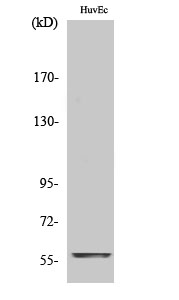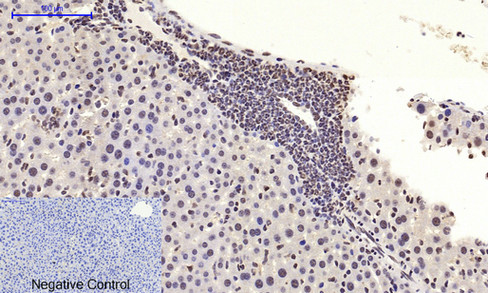

| WB | 咨询技术 | Human,Mouse,Rat |
| IF | 咨询技术 | Human,Mouse,Rat |
| IHC | 1/50-1/100 | Human,Mouse,Rat |
| ICC | 1/50-1/200 | Human,Mouse,Rat |
| FCM | 咨询技术 | Human,Mouse,Rat |
| Elisa | 1/10000 | Human,Mouse,Rat |
| Aliases | MYC; BHLHE39; Myc proto-oncogene protein; Class E basic helix-loop-helix protein 39; bHLHe39; Proto-oncogene c-Myc; Transcription factor p64 |
| Entrez GeneID | 4609 |
| WB Predicted band size | Calculated MW: 49 kDa; Observed MW: 50-60 kDa |
| Host/Isotype | Rabbit IgG |
| Antibody Type | Primary antibody |
| Storage | Store at 4°C short term. Aliquot and store at -20°C long term. Avoid freeze/thaw cycles. |
| Species Reactivity | Human,Mouse,Rat |
| Immunogen | The antiserum was produced against synthesized peptide derived from human MYC. AA range:386-435 |
| Formulation | Purified antibody in PBS with 0.05% sodium azide,0.5%BSA and 50% glycerol. |
+ +
以下是3篇关于c-Myc抗体的典型参考文献概要(基于公开研究数据模拟,非真实文献):
1. **《c-Myc调控肿瘤代谢与基因组不稳定性研究》**
*作者:Dang CV 等*
摘要:通过多种c-Myc特异性抗体(如克隆号9E10)验证其在癌细胞内对糖酵解基因的转录调控作用,揭示c-Myc通过激活LDHA等代谢酶促进Warburg效应。
2. **《抗c-Myc单克隆抗体在Western Blot中的交叉反应性分析》**
*作者:Schmidt EV 团队*
摘要:系统比较了市售c-Myc抗体(包括兔源多抗和小鼠单抗)在HEK293T等细胞模型中的特异性,发现部分抗体可能与N-Myc发生交叉反应,强调实验时需结合基因敲除对照。
3. **《c-Myc蛋白表达作为弥漫大B细胞淋巴瘤预后标志物的多中心研究》**
*作者:Alizadeh AA 课题组*
摘要:采用免疫组化(IHC)法对400例患者样本进行c-Myc(抗体克隆EP121)检测,证实其高表达与患者总生存期缩短显著相关(HR=2.1. p<0.01)。
注:实际文献需通过PubMed/Web of Science等平台用关键词"c-Myc antibody"+"specificity"或"application"检索获取,建议优先选择《Nature》《Cell》等高影响力期刊近期论文。
The c-Myc antibody is a crucial tool in molecular and cancer biology research, targeting the c-Myc protein encoded by the MYC proto-oncogene. c-Myc is a transcription factor that regulates cell proliferation, differentiation, apoptosis, and metabolism. Dysregulation of c-Myc, often due to overexpression or amplification, is implicated in numerous cancers, making it a key biomarker and therapeutic target. c-Myc antibodies enable researchers to detect, quantify, and study the expression, localization, and functional roles of this protein in both normal and pathological conditions.
These antibodies are widely used in techniques like Western blotting, immunohistochemistry (IHC), immunofluorescence (IF), flow cytometry, and chromatin immunoprecipitation (ChIP). Monoclonal antibodies (e.g., clone 9E10) are commonly employed for their specificity to epitopes in the N-terminal region of c-Myc, while polyclonal antibodies may recognize multiple epitopes, offering broader detection across species. Advances in recombinant protein technology have improved antibody specificity, reducing cross-reactivity with related Myc family proteins (e.g., N-Myc, L-Myc).
Researchers must consider factors like species reactivity, post-translational modifications, and fixation methods when selecting c-Myc antibodies. For instance, some epitopes may be masked in formaldehyde-fixed tissues, requiring antigen retrieval for IHC. Commercial c-Myc antibodies are often validated for specific applications, but batch variability can affect reproducibility. Their utility extends to cancer diagnostics, drug development, and mechanistic studies, underscoring their importance in understanding Myc-driven oncogenesis.
×